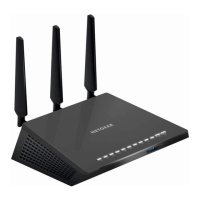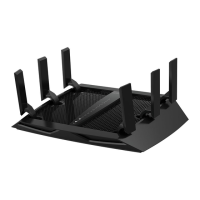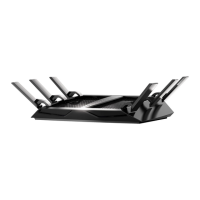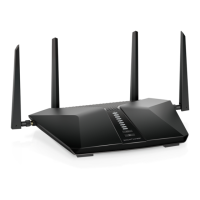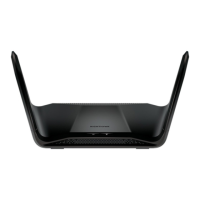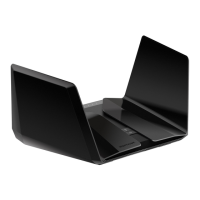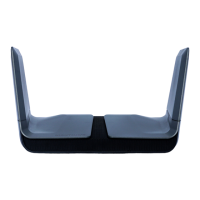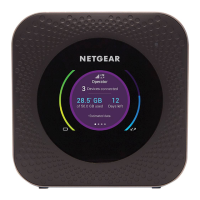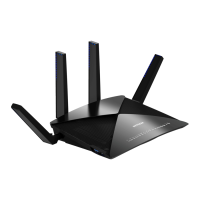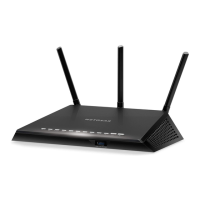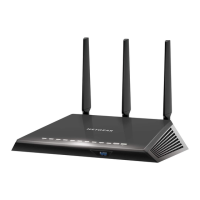
Do you have a question about the NETGEAR Nighthawk AC2600 and is the answer not in the manual?
| WiFi Range | Very large homes |
|---|---|
| Antennas | 4 external antennas |
| Beamforming | Yes |
| MU-MIMO | Yes |
| Memory | 128MB Flash and 512MB RAM |
| WiFi Technology | 802.11ac |
| WiFi Performance | AC2600 (800 + 1733 Mbps) |
| Processor | Dual Core 1.7GHz |
| Ethernet Ports | 5 x 10/100/1000 Mbps Gigabit Ethernet ports |
| Security | WPA2 |
Instructions for unpacking the router and identifying its components, including the router, antennas, Ethernet cable, and power adapter.
Description of the status LEDs and buttons on the router's top panel, explaining their function and behavior.
Details about the ports, buttons, and connectors located on the back panel of the router, including Reset, Ethernet LAN, and WAN ports.
Guidelines for placing the router to ensure optimal WiFi signal range and performance, avoiding interference.
Step-by-step instructions and diagram showing how to connect the router to your modem and power outlet.
Explains how to establish a connection to the router using either an Ethernet cable or WiFi.
Guide to installing and managing the router using the NETGEAR Nighthawk mobile application.
Instructions on how to access the router's web interface using a browser to configure settings.
Steps to change the display language of the router's web interface from the default Auto setting.
Detailed steps to manually configure the router's internet connection settings, including IP and DNS.
Configuration steps for internet connections requiring a login, such as PPPoE, L2TP, or PPTP.
Guide to setting up IPv6 internet connections, including auto-detect, auto-config, and specific types.
Explanation of MTU concepts and how to adjust the Maximum Transmission Unit size for optimal performance.
How to configure access control rules to allow or block specific devices from accessing the network.
Steps to block specific websites or domain names by entering keywords or domain names.
How to set up a schedule to block internet sites and services based on specific days and times.
Configure the router to send email notifications for security events or router activity logs.
Configure Wide Area Network (WAN) settings, including Port Scan, DMZ, Ping, MTU, and NAT Filtering.
Modify the router's LAN IP address, subnet mask, and RIP settings for network configuration.
Steps to change the WiFi password (network key) and select security options like WPA2-PSK.
Instructions for enabling and configuring a separate guest WiFi network with its own security settings.
Guide to configuring the router to operate in bridge mode for wireless connectivity at faster speeds.
How to enable Quality of Service (QoS) to prioritize internet streaming and applications.
Explanation of WMM QoS and how to enable or disable it for prioritizing WiFi voice and video traffic.
Steps to enable UPnP for devices like internet appliances and computers to access the network easily.
Instructions on how to check for and update the router's firmware to the latest version.
Steps to change the router's administrative login password for enhanced security.
How to back up, restore, or erase the router's configuration settings.
Configure and use remote management to access the router's settings over the Internet.
Procedures for resetting the router to its original factory default settings using the Reset button or Erase function.
Instructions on how to connect a USB storage device to the router's USB port for sharing.
Methods to access USB storage devices connected to the router via the Internet using Dynamic DNS or ReadyCLOUD.
Guide to using Apple's Time Machine software to back up Mac computers to a USB hard drive connected to the router.
Steps to safely disconnect a USB storage device from the router by taking it offline first.
Configure the router to act as a ReadyDLNA media server for viewing media on DLNA/UPnP AV-compliant players.
Instructions to set up the router's iTunes server for playing music from a USB device using iTunes.
Configure the router to allow TiVo devices to access media files stored on a USB device.
Steps for installing printer drivers and connecting a USB printer to the router's USB port.
How to use the NETGEAR USB Control Center utility to print documents through the connected USB printer.
Instructions on using the scan feature of a multifunction USB printer connected to the router.
How to allow specific incoming internet traffic to reach a server on your local network.
Procedure to add a port forwarding rule with a custom service or application not listed by default.
How to enable port triggering, which dynamically opens ports for applications when needed.
General tips for troubleshooting common network issues, including restarting sequence and cable checks.
Diagnosing router issues by observing the status and behavior of the front panel LEDs.
Steps to diagnose why the router can connect to the internet but computers cannot access web pages.
Steps to diagnose problems with connecting to the router's WiFi network, checking LEDs and settings.
Details of the router's default factory settings for various features like login, LAN, and WiFi.
A table listing the router's technical specifications, including protocols, power, dimensions, and WiFi standards.
